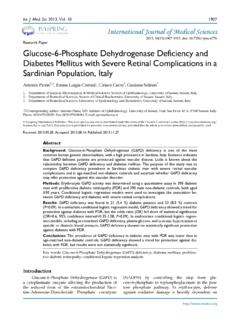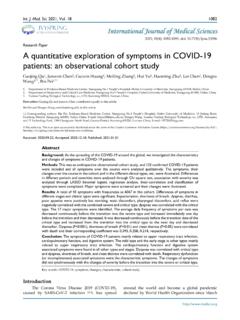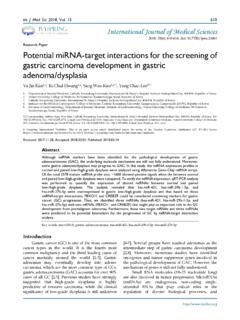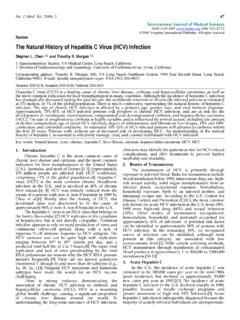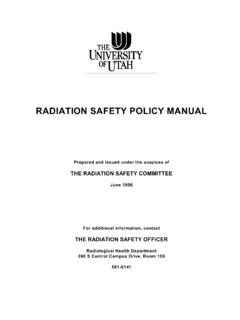Transcription of Review Cancer and Radiation Therapy: Current …
1 Int. J. Med. Sci. 2012, 9 193 IInntteerrnnaattiioonnaall JJoouurrnnaall ooff MMeeddiiccaall SScciieenncceess 2012; 9(3):193-199. doi: Review Cancer and Radiation therapy : Current Advances and Future Directions Rajamanickam Baskar1,2, , Kuo Ann Lee1, Richard Yeo1 and Kheng-Wei Yeoh1, 1. Department of Radiation Oncology, National Cancer Centre, 11- Hospital Drive, Singapore-169610, Singapore; 2. Division of Cellular and Molecular Research, National Cancer Centre, 11- Hospital Drive, Singapore-169610, Singapore. Corresponding author: R. Baskar, , , Department of Radiation Oncology, Molecular Radiation Biology Laboratory, Division of Cellular and Molecular Research, National Cancer Centre, 11- Hospital Drive, Singapore-169610, Tel: +65- 6436 8315 ; Fax: +65-6222 8675.
2 E-mail: OR Kheng-Wei Yeoh, MBBS, MRCP, MPH, FRCR, Department of Radiation Oncology, Division of Cel-lular and Molecular Research, National Cancer Centre, 11- Hospital Drive, Singapore-169610, Tel: +65- 6436 8315 ; Fax: +65-6222 8675. E-mail: Ivyspring International Publisher. This is an open-access article distributed under the terms of the Creative Commons License ( licenses/by-nc- ). Reproduction is permitted for personal, noncommercial use, provided that the article is in whole, unmodified, and properly cited. Received: ; Accepted: ; Published: Abstract In recent years remarkable progress has been made towards the understanding of proposed hallmarks of Cancer development and treatment. However with its increasing incidence, the clinical management of Cancer continues to be a challenge for the 21st century.
3 Treatment modalities comprise of Radiation therapy , surgery, chemotherapy, immunotherapy and hormonal therapy . Radiation therapy remains an important component of Cancer treatment with approximately 50% of all Cancer patients receiving Radiation therapy during their course of illness; it contributes towards 40% of curative treatment for Cancer . The main goal of ra-diation therapy is to deprive Cancer cells of their multiplication (cell division) potential. Celebrating a century of advances since Marie Curie won her second Nobel Prize for her research into radium, 2011 has been designated the Year of Radiation therapy in the UK. Over the last 100 years, ongoing advances in the techniques of Radiation treatment and progress made in understanding the biology of Cancer cell responses to Radiation will endeavor to increase the survival and reduce treatment side effects for Cancer patients.
4 In this Review , principles, application and advances in Radiation therapy with their biological end points are discussed. Key words: Cancer , Radiation therapy , Linear energy transfer, Cell death. Introduction Cancer remains leading cause of death globally. The International Agency for Research on Cancer (IARC) recently estimated that million deaths worldwide were due to Cancer with million new cases per year being reported worldwide. A signifi-cant proportion of this burden is borne by developing countries; 63% of Cancer deaths are reported to be from developing countries [1, 2, 3]. Cancer is a mul-tigenic and multicellular disease that can arise from all cell types and organs with a multi-factorial etiolo-gy.
5 Hanahan and Weinberg [4] have identified six Cancer cell phenotypes or hallmarks of Cancer : cells with unlimited proliferative potential, environmental independence for growth, evasion of apoptosis, an-giogenesis, invasion and metastasis to different parts of body. If uncontrolled cell growth or metastatic spread occurs it will result in death of the individual [5]. The past decade has witnessed a considerable progress towards the treatment and understanding of the earlier proposed hallmarks of Cancer [6] and to-gether with advances in early detection and in the various treatment modalities, many cancers have become curable [7]. After the discovery of X-rays in 1895, by Wilhelm Conrad R ntgen from Germany its clinical usefulness, as a means of Cancer treatment was first appreciated.
6 Ivyspring International Publisher Int. J. Med. Sci. 2012, 9 194 It is also one hundred years ago that Marie Curie won a second Nobel Prize for her research into radium, establishing her position as a pioneer in the field of Radiation therapy . To mark this, 2011 has been desig-nated the Year of Radiation therapy in the UK, cele-brating a century of advances. Since that time, radia-tion therapy has developed into a recognized medical specialty with Radiation Oncology being a discipline in which various health and science professionals from numerous disciplines work together. Along with surgery and chemotherapy, Radiation therapy or ra-diotherapy remains an important modality used in Cancer treatment being a highly cost effective single modality treatment accounting about only 5% of the total cost of Cancer care [8].
7 Furthermore, approxi-mately 50% of all Cancer patients will receive Radiation therapy during their course of illness [9, 10] with an estimation that Radiation therapy contributes to around 40% towards curative treatment [11]. Rapid progress in this field continues to be boosted by ad-vances in imaging techniques, computerized treat-ment planning systems, Radiation treatment machines (with improved X-ray production and treatment de-livery) as well as improved understanding of the ra-diobiology of Radiation therapy [12]. Principles of Radiation therapy Radiation is a physical agent, which is used to destroy Cancer cells. The Radiation used is called ion-izing Radiation because it forms ions (electrically charged particles) and deposits energy in the cells of the tissues it passes through.
8 This deposited energy can kill Cancer cells or cause genetic changes resulting in Cancer cell death. High-energy Radiation damages genetic material (deoxyribonucleic acid, DNA) of cells and thus blocking their ability to divide and proliferate further [13]. Although Radiation damages both normal cells as well as Cancer cells, the goal of Radiation therapy is to maximize the Radiation dose to abnormal Cancer cells while minimizing exposure to normal cells, which is adjacent to Cancer cells or in the path of Radiation . Normal cells usually can repair themselves at a faster rate and retain its normal function status than the Cancer cells. Cancer cells in general are not as efficient as normal cells in repairing the damage caused by Radiation treatment resulting in differential Cancer cell killing [10].
9 Radiation can be given with the intent of cure as well as being used as a very effective modality of pal-liative treatment to relieve patients from symptoms caused by the Cancer . Further indications of Radiation therapy include combination strategies with other treatment modalities such as surgery, chemotherapy or immunotherapy. If used before surgery (neoadju-vant therapy ), Radiation will aim to shrink the tumor. If used after surgery (adjuvant therapy ), Radiation will destroy microscopic tumor cells that may have been left behind. It is well known that tumors differ in their sensitivity to Radiation treatment. Table 1 shows a list of common cancers treated with Radiation therapy . There are two ways to deliver Radiation to the location of the Cancer .
10 External beam Radiation is de-livered from outside the body by aiming high-energy rays (photons, protons or particle Radiation ) to the location of the tumor. This is the most common ap-proach in the clinical setting. Internal Radiation or brachytherapy is delivered from inside the body by radioactive sources, sealed in catheters or seeds di-rectly into the tumor site. This is used particularly in the routine treatment of gynecological and prostate malignancies as well as in situations where retreat-ment is indicated, based on its short range effects. Table 1. Examples of cancers treated with Radiation therapy . Early cancers curable with radi-ation therapy alone Cancers curable with Radiation therapy in combination with other modalities Skin cancers (Squamous and Basel cell) Breast carcinomas Prostate carcinomas Rectal and anal carcinomas Lung carcinomas (non-small cell) Local advanced cervix carcino-mas Cervix carcinomas Locally advanced head and neck carcinomas Lymphomas (Hodgkin s and low grade Non-Hodgkin s)

